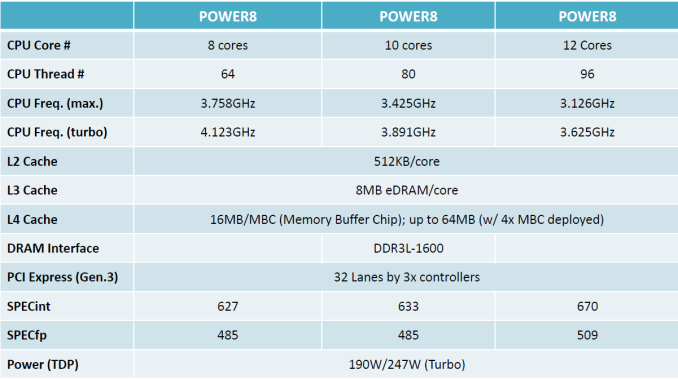The Intel Xeon E7-8800 v3 Review: The POWER8 Killer?
by Johan De Gelas on May 8, 2015 8:00 AM EST- Posted in
- CPUs
- IT Computing
- Intel
- Xeon
- Haswell
- Enterprise
- server
- Enterprise CPUs
- POWER
- POWER8
The Competitor: IBM's POWER8
As we briefly mentioned in the introduction, among all of the potential competitors for the Xeon E7 line, IBM's OpenPower might be the most potent competitor at this time. So how do IBM's offerings compare to Intel's? IBM POWER 8 is a Brainiac (high IPC) design that also wants to be speed demon (high clock speeds).
The POWER8 core can decode, issue and execute and retire 8 instructions per cycle. That degree of of instruction level parallelism (ILP) can not be extracted out of (most) software. To battle the lack of ILP in software, no less than 8 threads (SMT) are active per core. According to IBM,
- 2-threads delivers about 45% performance more than one
- 4-threads deliver yet another 30% boost
- the last 4-threads deliver about 7%
So in total, the 8-way SMT doubles the performance of this massive core. Let us compare the two chips.
| Xeon E7v3/POWER8 Comparison | ||
| Feature | Intel Haswell-EX Xeon E7 |
IBM POWER8 |
| Process tech. | 22nm FinFET | 22nm SOI |
| Max clock | 2.5-3.6 GHz | 3.5-4.35 GHz |
| Max. core count Max. thread count |
18@2.5 GHz 36 SMT |
12@4.2 GHz 96 SMT |
| Max. sustained IPC | 6 (4) | 8 |
| L1-I / L1-D Cache | 32 KB/32 KB | 32 KB/64 KB |
| L2 Cache | 256 KB SRAM per core | 512 KB SRAM per core |
| L3 Cache | 2.5 MB SRAM per core | 8 MB eDRAM per core |
| L4 Cache | None | 16 MB eDRAM per MBC (64/128 MB total) |
| Memory | 1.5 TB per socket (64 GB per DIMM) |
1-2 TB per socket (64 GB per DIMM) |
| Theoretical Memory Bandwidth | 102 GB/s (independent mode) |
204 GB/s |
| PCIe 3.0 Lanes | 40 Lanes | 32 Lanes |
The POWER8 looks better than Haswell-EX in almost every spec, but the devil is of course in the details. First of all, Intel's L2-cache works at the same clock as the core, IBM's L2-cache runs at a lower clock (2.2 GHz or less, depending on the model). Secondly, the POWER8's L3 eDRAM cache might be much larger, but it is so also a bit slower.
But the main disadvantage of the POWER8 is that all this superscalar wideness and high clockspeed goodness comes with a power price. This slide from Tyan at the latest OpenPOWER conference tell us more.
A 12 core POWER8 is "limited" to 3.1 GHz if you want to stay below the 190W TDP mark. Clockspeeds higher than 4 GHz are only possible with 8-cores and a 250W TDP. This makes us really curious what kind of power dissipation we may expect from the 4.2 GHz 10-core POWER8 inside the expensive E870 Enterprise systems (300W?).
That is not all. Each "Jordan Creek2" memory buffer on the Intel system is limited to about 9W. IBM uses a similar but more complex "Centaur" memory buffer (including a 16 MB cache) which needs more than twice as much energy (16-20W). There are at least four of them per chip, and a high-end chip can have eight. So in total the Intel CPU plus memory buffers have a 201W TDP (165W CPU + 4x9W Jordan Creek 2), while the IBM platform has at best a 270W TDP (190W CPU+ 4x20W MBC).











146 Comments
View All Comments
MyNuts - Tuesday, May 12, 2015 - link
Charles Babbage would be upsetquadibloc - Thursday, May 14, 2015 - link
I'm shocked to hear that Oracle and IBM are charging more for their SPARC and PowerPC chips, respectively, than Intel is charging for comparable x86 chips - or, at least, I presume they are, if servers using those chips are more expensive. Since x86 has the enormous advantage of being able to run Microsoft Windows, the only way other ISAs can be viable is if they offer better performance or a lower price.Kevin G - Thursday, May 14, 2015 - link
Actually IBM comes in cheaper than Intel for comparable POWER8 hardware. IBM now is offering the processor to outside system builders so the actual prices are some what known. Tyan used to have the raw prices on their site but I can't find them again.Regardless, this article indicates that they top out at $3000 which is less than equivalent Xeon E7's.
kgardas - Thursday, May 21, 2015 - link
Sure, SPARC and POWER are (was in case of POWER) more expensive, but usually hardware price is nothing in comparison with software price if you are running enterprise. Also SPARC is also Oracle preferred over POWER/Itanium by Oracle's price ratios... Anyway, POWER8 looks so powerful that it may even be cheaper software wise in comparison with SPARC, but that would need some clever Oracle DB benchmarking...HighTech4US - Friday, May 15, 2015 - link
Power 9 will be available when?Phiro69 - Friday, May 15, 2015 - link
I wanted to compare the E7's in this review to the E5's reviewed a few months back in your benchmark comparison tool, but I'm not seeing any of this data in it? Is it going to be there?